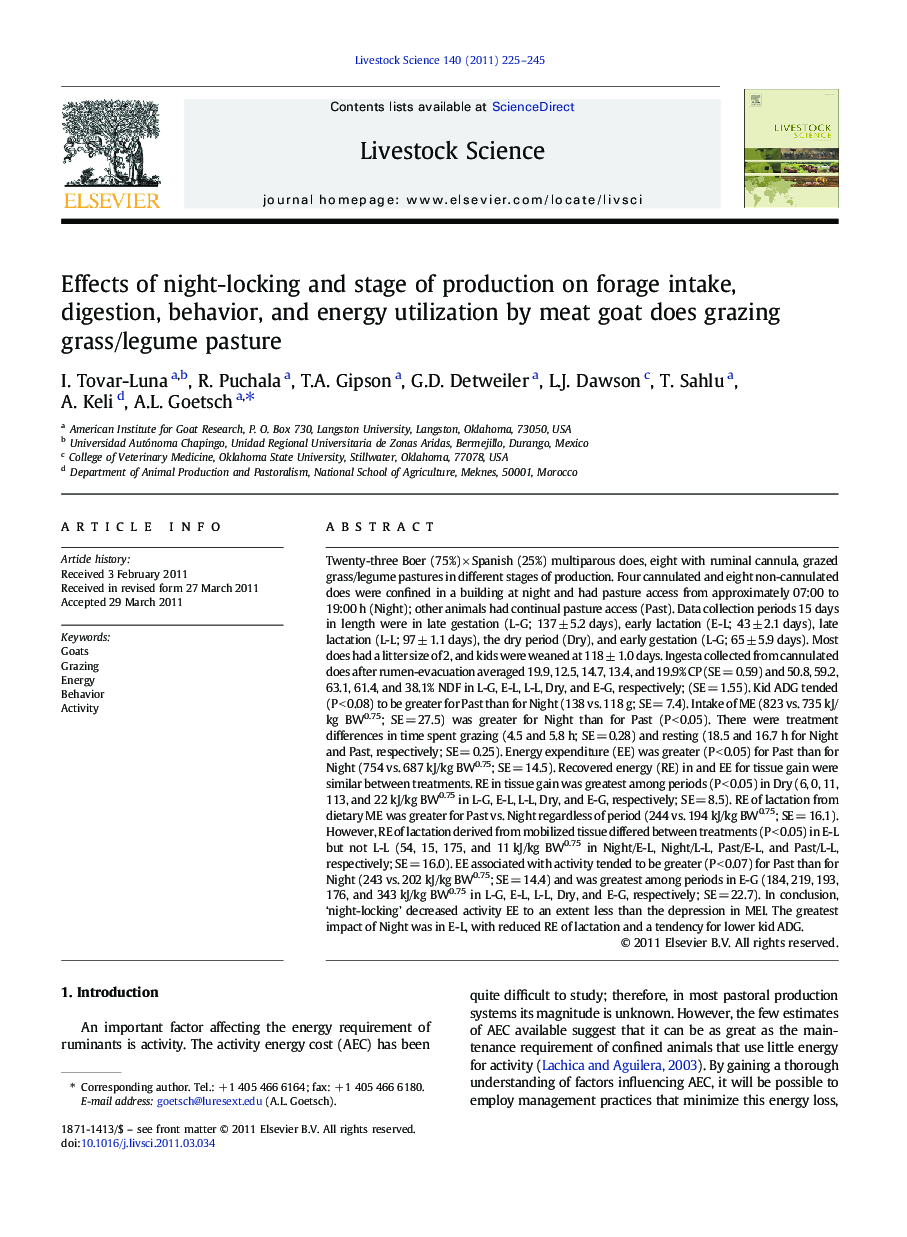| کد مقاله | کد نشریه | سال انتشار | مقاله انگلیسی | نسخه تمام متن |
|---|---|---|---|---|
| 5790906 | 1553992 | 2011 | 21 صفحه PDF | دانلود رایگان |

Twenty-three Boer (75%) Ã Spanish (25%) multiparous does, eight with ruminal cannula, grazed grass/legume pastures in different stages of production. Four cannulated and eight non-cannulated does were confined in a building at night and had pasture access from approximately 07:00 to 19:00 h (Night); other animals had continual pasture access (Past). Data collection periods 15 days in length were in late gestation (L-G; 137 ± 5.2 days), early lactation (E-L; 43 ± 2.1 days), late lactation (L-L; 97 ± 1.1 days), the dry period (Dry), and early gestation (L-G; 65 ± 5.9 days). Most does had a litter size of 2, and kids were weaned at 118 ± 1.0 days. Ingesta collected from cannulated does after rumen-evacuation averaged 19.9, 12.5, 14.7, 13.4, and 19.9% CP (SE = 0.59) and 50.8, 59.2, 63.1, 61.4, and 38.1% NDF in L-G, E-L, L-L, Dry, and E-G, respectively; (SE = 1.55). Kid ADG tended (P < 0.08) to be greater for Past than for Night (138 vs. 118 g; SE = 7.4). Intake of ME (823 vs. 735 kJ/kg BW0.75; SE = 27.5) was greater for Night than for Past (P < 0.05). There were treatment differences in time spent grazing (4.5 and 5.8 h; SE = 0.28) and resting (18.5 and 16.7 h for Night and Past, respectively; SE = 0.25). Energy expenditure (EE) was greater (P < 0.05) for Past than for Night (754 vs. 687 kJ/kg BW0.75; SE = 14.5). Recovered energy (RE) in and EE for tissue gain were similar between treatments. RE in tissue gain was greatest among periods (P < 0.05) in Dry (6, 0, 11, 113, and 22 kJ/kg BW0.75 in L-G, E-L, L-L, Dry, and E-G, respectively; SE = 8.5). RE of lactation from dietary ME was greater for Past vs. Night regardless of period (244 vs. 194 kJ/kg BW0.75; SE = 16.1). However, RE of lactation derived from mobilized tissue differed between treatments (P < 0.05) in E-L but not L-L (54, 15, 175, and 11 kJ/kg BW0.75 in Night/E-L, Night/L-L, Past/E-L, and Past/L-L, respectively; SE = 16.0). EE associated with activity tended to be greater (P < 0.07) for Past than for Night (243 vs. 202 kJ/kg BW0.75; SE = 14.4) and was greatest among periods in E-G (184, 219, 193, 176, and 343 kJ/kg BW0.75 in L-G, E-L, L-L, Dry, and E-G, respectively; SE = 22.7). In conclusion, 'night-locking' decreased activity EE to an extent less than the depression in MEI. The greatest impact of Night was in E-L, with reduced RE of lactation and a tendency for lower kid ADG.
Journal: Livestock Science - Volume 140, Issues 1â3, September 2011, Pages 225-245